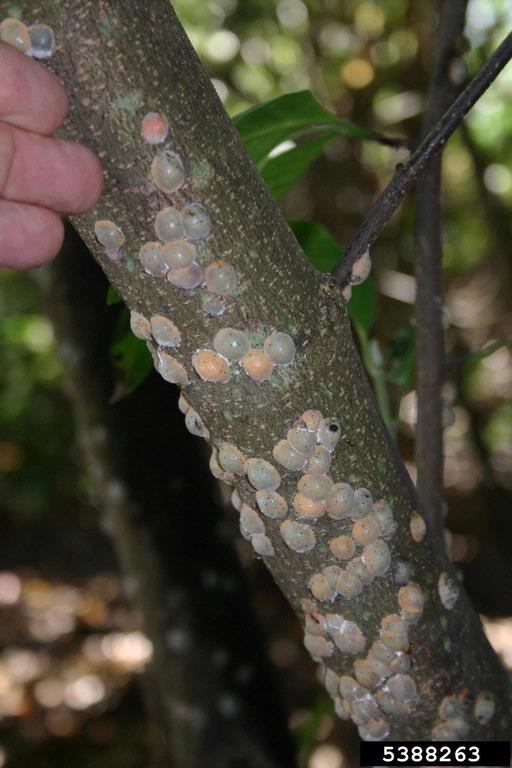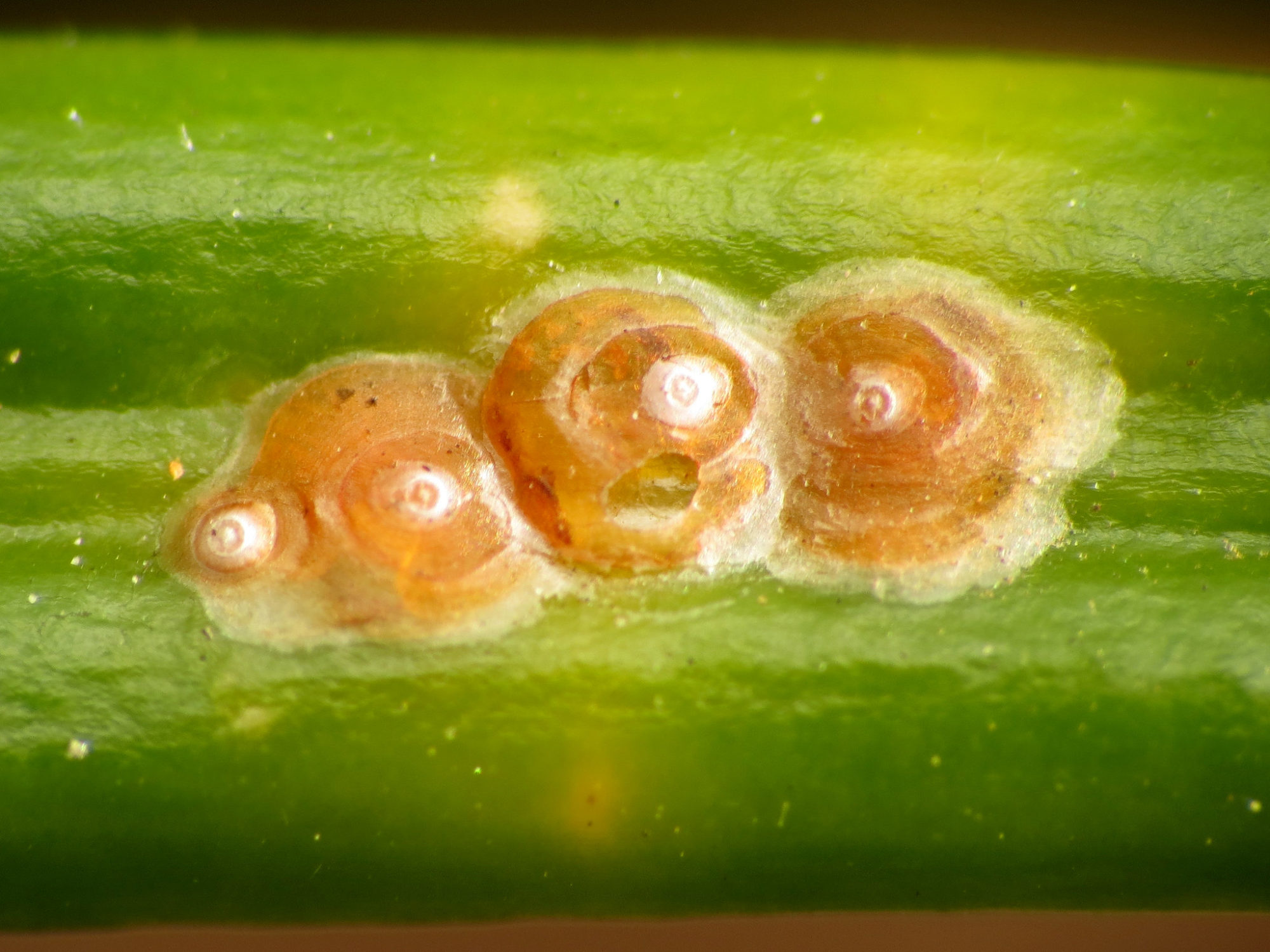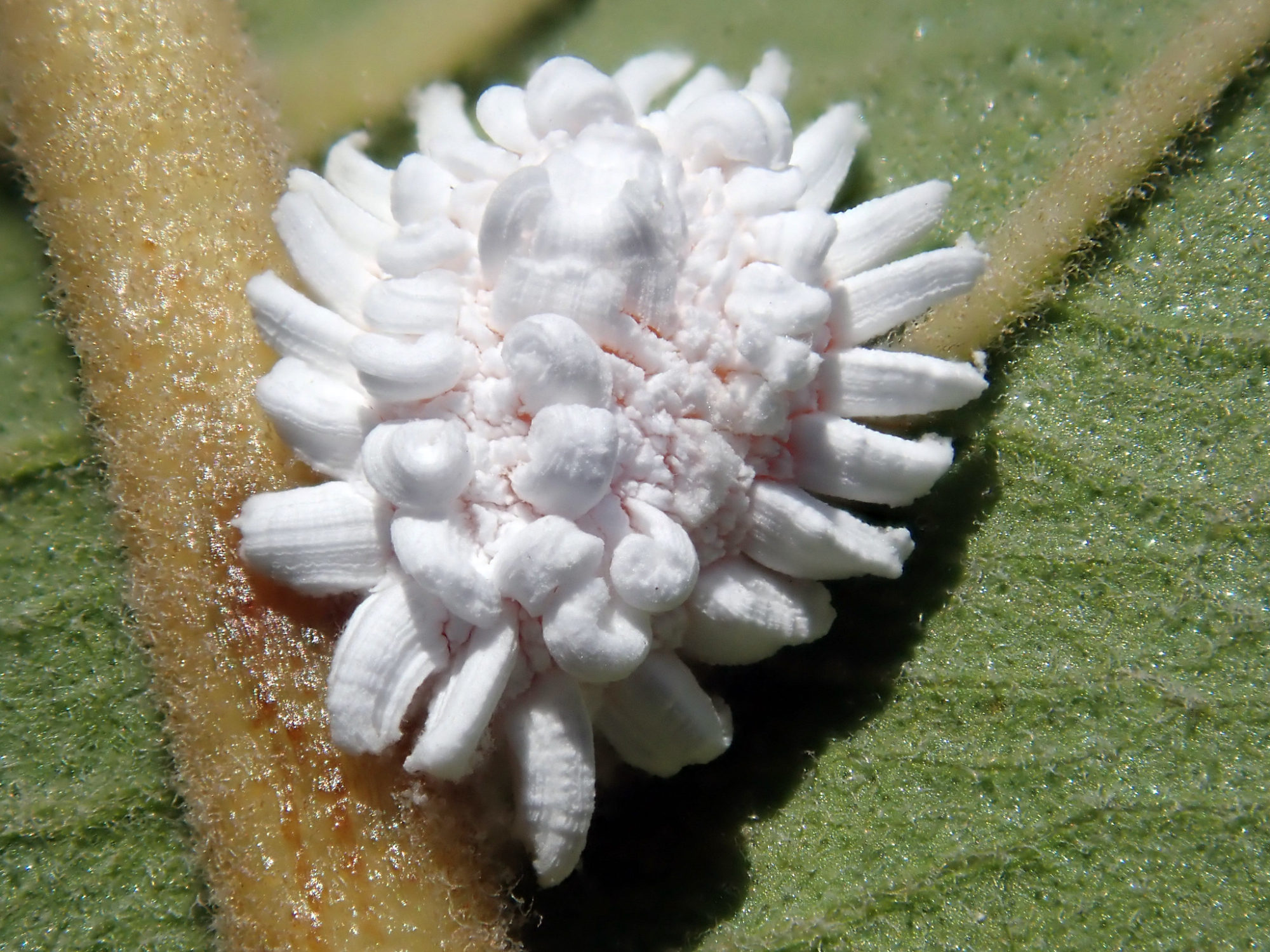A wart. A lump. An inconspicuous bump. Many scale insects can go undetected due to the protective, waxy, shell-like covering that is often mistaken for a protuberance of the plant itself. Scale are sap-feeding insects that use their mouthparts to pierce and suck plant nutrients. Results of a scale attack vary depending on the species, but can range between a weakened plant, yellowing leaves, stunted growth, a disruption in photosynthesis, die back or killing of the plant entirely. Orchard plants that scale insects commonly attack include fruit and nut trees, grapes, currants, raspberries and blueberries.
Identification and Life Cycle
Worldwide there are over 8,000 species of scale insects with 1,000 existing in North America. Scale are a part of the order Hemiptera, which also contain whiteflies and aphids. The two most common families of scale pests are armored scale (Diaspididae) and soft scale (Coccoidea).
Armored scale insects are circular or oval in shape, with a protective, shell-like waxy covering made from secretions and cast skins from previous stages of growth that range from 1/16” to 1/8” long. Colors may vary between reddish brown, yellow to white and gray. The life cycle of an armored scale depends on the species. Armored scale can reproduce either sexually or asexually and females can either lay eggs or produce live offspring. A female scale can lay up to 2,000 eggs, which overwinter under their protective covering. Between late May and early June, the eggs hatch and emerge as crawlers, flat and mobile orange, yellow or gray colored nymphs that are typically found on the underside of branches, leaves or the sides of tree trunks; this is primarily how armored scale infestation spreads. Once they find a feeding location, female crawlers will become immobile and remain in the same location for the rest of their lives, building the waxy protective covering on their body, feeding on plant nutrients and injecting a saliva that may be toxic to the plant. Males will eventually molt into small, winged insects that fertilize females. Armored scales may produce 1-4 generations each year depending on the species and weather conditions.
Most species of soft scale are round or oval in shape and 1/10” to ¼ inch long. They are much larger than armored scale species and come in a range of colors, often resembling fluffy insect casings, but depending on species can blend in with a plant’s coloring making them challenging to detect. During the winter, soft scales overwinter as young fertilized nymphs and attach themselves to twigs on the host plant. After development is complete, soft scale females lay their eggs which hatch around late June and early July. Soft scale crawlers will leave the twigs and move towards the undersides of leaves where they will feed on sap all summer directly from the plant’s phloem, the living tissue that transports organic compounds made during photosynthesis . While feeding, soft scales excrete a sticky honeydew that attracts ants and a dark fungus called black sooty mold. The fungus feeds on the honeydew, coats the leaves in what appears to be a layer of soot and interferes with photosynthesis. Soft scale insects produce 1-2 generations a year outdoors, but this is contingent on the species and weather conditions.
Management
Many species of scale are naturally controlled by beneficial predators such as soldier beetles, lady beetles and parasitic wasps. This however, can be thwarted by ants, who are attracted to the sweet honeydew secreted by soft scale insects. According to Gardening Know How, ants are the first sign of soft scale infestation. The clever ant will pick up the soft scale and move them around different parts of the plant for more access to sap. In turn, the ants will feed on the honeydew the scale produces. Ants are also capable of protecting their precious scales, by chasing away or killing predators that would otherwise keep soft scales under control. Due to the nature of this symbiotic relationship, ant management is also a part of soft scale management. Fine Gardening recommends that ants be washed off with insecticidal soap and water, followed by a band of sticky adhesive at the base of the trunk to prevent ants from climbing up.

PHOTO CREDIT: William Fountain, University of Kentucky, Bugwood.org
Scout for scale in the early spring to monitor for emerging crawlers. Crawlers can also be washed off with insecticidal soap and water, but larger infestations may be controlled with a well-timed application of horticultural oil will destroy scale while keeping predators that will feed on young crawlers. According to The Organic Gardener’s Handbook of Natural Pest and Disease Control, proper application involves using a dormant-season dilution on fruit or ornamental trees in the winter or very early spring before or just as buds swell and a growing-season dilution during other times of the season. Armored scale adults are harder to kill once protected by their waxy coverings. Small populations of armored scale may be removed with a hand brush, but larger populations may need growing-season applications for effective management.
Prune and dispose of infested branches and twigs, especially on bramble, since scale infestations are generally worse in plantings that have old canes with rough bark and good hiding places. Penn State Expansion has additional information on scale management, specifically for blueberries in the northeastern U.S.
This POP Blog was written by Orchard Manager Sharon Appiah
SUPPORT US! If you found this entry useful, informative, or inspiring, please consider a donation of any size to help POP in planting and supporting community orchards in Philadelphia: phillyorchards.org/donate.
Sources
Fern Marshall Bradley, Barbara W. Ellis, Deborah L. Martin. 2009. “The Organic Gardener’s Handbook of Natural Pest and Disease Control”
https://content.ces.ncsu.edu/armored-scale-identification-and-management-on-ornamental-plants
https://hort.extension.wisc.edu/articles/scale-insects/
http://ipm.ucanr.edu/PMG/PESTNOTES/pn7408.html
https://www.gardeningknowhow.com/plant-problems/pests/insects/what-is-soft-scale.htm
https://extension.psu.edu/watch-for-scale-insects-on-blueberries-while-you-are-pruning

